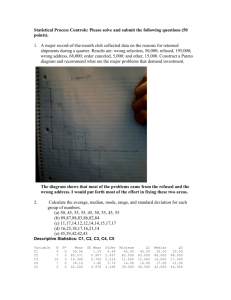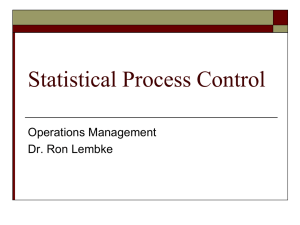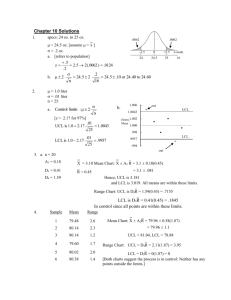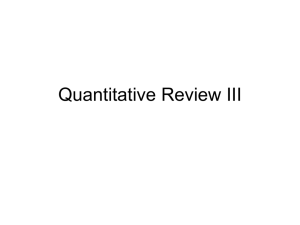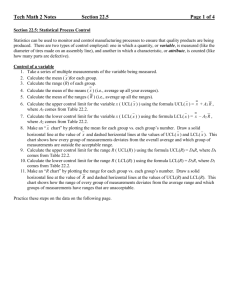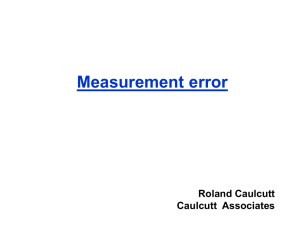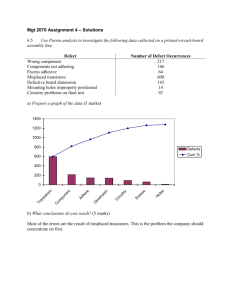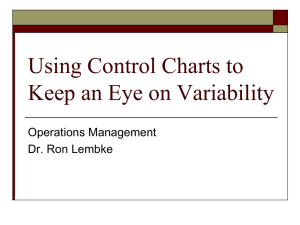Chapter 5 Exercise Solutions
advertisement
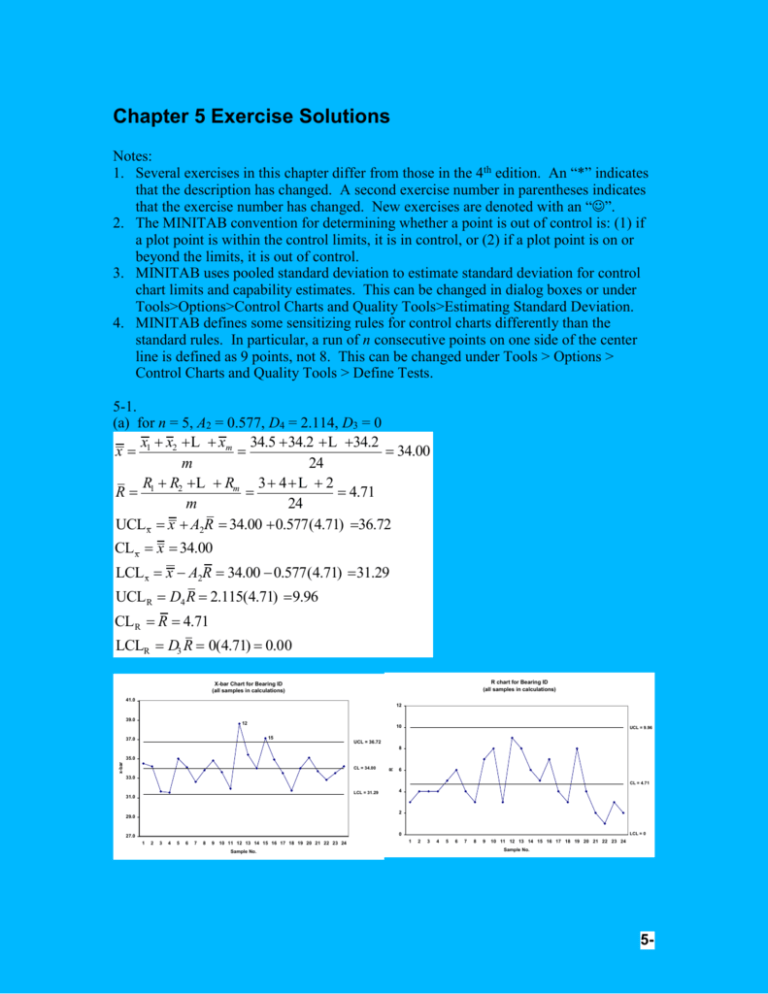
Chapter 5 Exercise Solutions
Notes:
1. Several exercises in this chapter differ from those in the 4th edition. An “*” indicates
that the description has changed. A second exercise number in parentheses indicates
that the exercise number has changed. New exercises are denoted with an “”.
2. The MINITAB convention for determining whether a point is out of control is: (1) if
a plot point is within the control limits, it is in control, or (2) if a plot point is on or
beyond the limits, it is out of control.
3. MINITAB uses pooled standard deviation to estimate standard deviation for control
chart limits and capability estimates. This can be changed in dialog boxes or under
Tools>Options>Control Charts and Quality Tools>Estimating Standard Deviation.
4. MINITAB defines some sensitizing rules for control charts differently than the
standard rules. In particular, a run of n consecutive points on one side of the center
line is defined as 9 points, not 8. This can be changed under Tools > Options >
Control Charts and Quality Tools > Define Tests.
5-1.
(a) for n = 5, A2 = 0.577, D4 = 2.114, D3 = 0
x x L xm 34.5 34.2 L 34.2
x 1 2
34.00
m
24
R R2 L Rm 3 4 L 2
R 1
4.71
m
24
UCL x x A2R 34.00 0.577(4.71) 36.72
CL x x 34.00
LCL x x A2R 34.00 0.577(4.71) 31.29
UCL R D4 R 2.115(4.71) 9.96
CL R R 4.71
LCLR D3 R 0(4.71) 0.00
R chart for Bearing ID
(all samples in calculations)
X-bar Chart for Bearing ID
(all samples in calculations)
41.0
12
39.0
12
10
15
37.0
UCL = 9.96
UCL = 36.72
8
CL = 34.00
R
x-bar
35.0
6
33.0
CL = 4.71
LCL = 31.29
31.0
4
2
29.0
0
27.0
1
2
3
4
5
6
7
8
9
10 11 12 13 14 15 16 17 18 19 20 21 22 23 24
Sample No.
LCL = 0
1
2
3
4
5
6
7
8
9
10 11 12 13 14 15 16 17 18 19 20 21 22 23 24
Sample No.
51
1
Chapter 5 Exercise Solutions
5-1 (a) continued
The process is not in statistical control; x is beyond the upper control limit for both
Sample No. 12 and Sample No. 15. Assuming an assignable cause is found for these two
out-of-control points, the two samples can be excluded from the control limit
calculations. The new process parameter estimates are:
x 33.65; R 4.5; ˆ x R / d 2 4.5/ 2.326 1.93
UCL x 36.25;CL x 33.65;LCL x 31.06
UCL R 9.52;CL R 4.5; LCL R 0.00
x-bar Chart for Bearing ID
(samples 12, 15 excluded)
R chart for Bearing ID
(samples 12, 15 excluded)
41.0
12
39.0
12
10
UCL = 9.52
15
37.0
UCL =36.25
8
CL = 33.65
R
x-bar
35.0
6
33.0
CL = 4.50
4
31.0
LCL = 31.06
29.0
2
27.0
1
2
3
4
5
6
7
8
9
10 11 12 13 14 15 16 17 18 19 20 21 22 23 24
0
LCL = 0
1
2
3
4
Sample No.
5
6
7
8
9
10 11 12 13 14 15 16 17 18 19 20 21 22 23 24
Sample No.
(b)
pˆ Pr{ x LSL} Pr{ x USL} Pr{ x 20} Pr{ x 40} Pr{ x 20} 1 Pr{ x40}
20 33.65
40 33.65
1
1.93
1.93
(7.07) 1 (3.29) 0 1 0.99950 0.00050
-3.
(a)
5
MTB > Stat > Control Charts > Variables Charts for Subgroups > Xbar-R
52
1
Chapter 5 Exercise Solutions
Xbar-R Chart of Ex5-3Dia
U C L=47.53
Sample M ean
40
20
_
_
X=10.9
0
-20
LC L=-25.73
2
4
6
8
10
Sample
12
14
16
18
20
150
Sample Range
U C L=134.3
100
_
R=63.5
50
0
LC L=0
2
4
6
8
10
Sample
12
14
16
18
20
The process is in statistical control with no out-of-control signals, runs, trends, or
cycles.5-3 continued
(b)
ˆ
R
/
d
6
3
.
5
/
2
.
3
2
6
2
7
.
3
x
2
(c)
USL = +100, LSL = –100
USL LSL 100 ( 100)
CˆP
1.22 , so the process is capable.
6ˆ x
6(27.3)
MTB > Stat > Quality Tools > Capability Analysis > Normal
53
1
Chapter 5 Exercise Solutions
Process Capability Analysis of Ex5-3Dia
LSL
USL
Process Data
LSL
-100.00000
Target
*
USL
100.00000
Sample Mean
10.90000
Sample N
100
StDev(Within)
27.30009
StDev(Overall)
25.29384
Within
Ov erall
Potential (Within) Capability
Cp
1.22
CPL
1.35
CPU
1.09
Cpk
1.09
CCpk
1.22
Overall Capability
Pp
PPL
PPU
Ppk
Cpm
-90
Observed Performance
PPM < LSL
0.00
PPM > USL
0.00
PPM Total
0.00
-60
-30
Exp. Within Performance
PPM < LSL
24.30
PPM > USL
549.79
PPM Total
574.09
0
30
60
1.32
1.46
1.17
1.17
*
90
Exp. Overall Performance
PPM < LSL
5.81
PPM > USL
213.67
PPM Total
219.48
5-5.
(a)
MTB > Stat > Control Charts > Variables Charts for Subgroups > Xbar-S (Ex5-5Vol)
Under “Options, Estimate” select Sbar as method to estimate standard deviation.
Xbar-S Chart of Fill Volume (Ex5-5Vol)
U C L=1.037
Sample M ean
1.0
0.5
_
_
X=-0.003
0.0
-0.5
-1.0
LC L=-1.043
1
2
3
4
5
6
7
8
Sample
9
10
11
12
13
14
15
2.0
Sample StDev
U C L=1.830
1.5
_
S =1.066
1.0
0.5
LC L=0.302
1
2
3
4
5
6
7
8
Sample
9
10
11
12
13
14
15
The process is in statistical control, with no out-of-control signals, runs, trends, or cycles.
(b)
MTB > Stat > Control Charts > Variables Charts for Subgroups > Xbar-R (Ex5-5Vol)
54
1
Chapter 5 Exercise Solutions
Xbar-R Chart of Fill Volume (Ex5-5Vol)
Sample M ean
1.0
U C L=0.983
0.5
_
_
X=-0.003
0.0
-0.5
-1.0
LC L=-0.990
1
2
3
4
5
6
7
8
Sample
9
10
11
12
13
14
15
Sample Range
6.0
U C L=5.686
4.5
_
R=3.2
3.0
1.5
LC L=0.714
0.0
1
2
3
4
5
6
7
8
Sample
9
10
11
12
13
14
15
The process is in statistical control, with no out-of-control signals, runs, trends, or cycles.
There is no difference in interpretation from the x s chart.5-5 continued
(c)
Let = 0.010. n = 15, s = 1.066.
CL s 2 1.066 2 1.136
2
2
UCL s 2 (n 1) 2 / 2,n 1 1.066 2 (15 1) 0.010/
2,15 1 1.066 (15 1) 31.32 2.542
LCL s 2 (n 1) 12( / 2), n1 1.0662 (15 1) 12(0.010/ 2),15 1 1.066 2 (15 1) 4.07 0.330
MINITAB’s control chart options do not include an s2 or variance chart. To construct an
s2 control chart, first calculate the sample standard deviations and then create a time
series plot. To obtain sample standard deviations: Stat > Basic Statistics > Store
Descriptive Statistics. “Variables” is column with sample data (Ex5-5Vol), and “By
Variables” is the sample ID column (Ex5-5Sample). In “Statistics” select “Variance”.
Results are displayed in the session window. Copy results from the session window by
holding down the keyboard “Alt” key, selecting only the variance column, and then
copying & pasting to an empty worksheet column (results in Ex5-5Variance).
Graph > Time Series Plot > Simple
Control limits can be added using: Time/Scale > Reference Lines > Y positions
55
1
Chapter 5 Exercise Solutions
Control Chart for Ex5-5Variance
UCL = 2.542
2.5
s^2 (Variance)
2.0
1.5
CL = 1.136
1.0
0.5
LCL = 0.33
0.0
1
2
3
4
5
6
7
8
9
Sample
10
11
12
13
14 15
Sample 5 signals out of control below the lower control limit. Otherwise there are no
runs, trends, or cycles. If the limits had been calculated using = 0.0027 (not tabulated
in textbook), sample 5 would be within the limits, and there would be no difference in
interpretation from either the x s or the xR chart.5-13* (5-11).
50
50
i1
i1
n 4 items/subgroup; xi 1000; Si 72; m 50 subgroups
(a)
50
xi
1000
x i 1
20
m
50
50
Si
72
1.44
m
50
UCL x x A3S 20 1.628(1.44) 22.34
S
i1
LCL x x A3S 20 1.628(1.44) 17.66
UCL S B4 S 2.266(1.44) 3.26
LCL S B3S 0(1.44) 0
(b)
S
1.44
natural process tolerance limits: x 3ˆ x x 3 20 3
[15.3,24.7]
0.9213
c4
56
1
Chapter 5 Exercise Solutions
(c)
USL - LSL
4.0 ( 4.0)
CˆP
0.85 , so the process is not capable.
6ˆ x
6(1.44 / 0.9213)
(d)
23 20
pˆ rework Pr{ x USL} 1 Pr{ x USL} 1
1 (1.919) 1 0.9725 0.0275
1.44 / 0.9213
or 2.75%.
15 20
pˆ scrap Pr{ x LSL}
(3.199) 0.00069 , or 0.069%
1.44 / 0.9213
Total = 2.88% + 0.069% = 2.949%
(e)
23 19
pˆ rework 1
1 (2.56) 1 0.99477 0.00523 , or 0.523%
1.44 / 0.9213
15 19
pˆ scrap
(2.56) 0.00523 , or 0.523%
1.44 / 0.9213
Total = 0.523% + 0.523% = 1.046%
Centering the process would reduce rework, but increase scrap. A cost analysis is needed
to make the final decision. An alternative would be to work to improve the process by
reducing variability.5-26.
MTB > Stat > Control Charts > Variables Charts for Subgroups > Xbar-R
Sample M ean
Xbar-R Chart of TiW Thickness (Ex5-26Th)
460
U C L=460.82
450
_
_
X=448.69
440
LC L=436.56
430
1
2
4
6
8
10
Sample
12
14
16
18
20
Sample Range
40
U C L=37.98
30
20
_
R=16.65
10
0
LC L=0
2
4
6
8
10
Sample
12
14
16
18
20
Test Results for Xbar Chart of Ex5-26Th
TEST 1. One point more than 3.00 standard deviations from center line.
Test Failed at points: 18
The process is out of control on the x chart at subgroup 18. Excluding subgroup 18
from control limits calculations:
57
1
Chapter 5 Exercise Solutions
Xbar-R Chart of TiW Thickness (Ex5-26Th)
Excluding subgroup 18 from calculations
UCL=461.88
Sample Mean
460
_
_
X=449.68
450
440
LCL=437.49
430
1
2
4
6
8
10
Sample
12
14
16
18
20
Sample Range
40
UCL=38.18
30
20
_
R=16.74
10
0
LCL=0
2
4
6
8
10
Sample
12
14
16
18
20
Test Results for Xbar Chart of Ex5-26Th
TEST 1. One point more than 3.00 standard deviations from center line.
Test Failed at points: 18
No additional subgroups are beyond the control limits, so these limits can be used for
future production.5-26 continued
(b)
Excluding subgroup 18:
x 449.68
ˆ x R / d2 16.74 / 2.059 8.13
(c)
MTB > Stat > Basic Statistics > Normality Test
58
1
Chapter 5 Exercise Solutions
Probability Plot of TiW Thickness (Ex5-26Th)
Normal
99.9
Mean
StDev
N
AD
P-Value
99
95
Percent
90
448.7
9.111
80
0.269
0.672
80
70
60
50
40
30
20
10
5
1
0.1
420
430
440
450
Ex5-26Th
460
470
480
A normal probability plot of the TiW thickness measurements shows the distribution is
close to normal.5-26 continued
(d)
USL = +30, LSL = –30
USL LSL 30 (30)
CˆP
1.23 , so the process is capable.
6ˆ x
6(8.13)
MTB > Stat > Quality Tools > Capability Analysis > Normal
59
1
Chapter 5 Exercise Solutions
Process Capability Analysis of TiW Thickness (Ex5-26Th)
LSL
USL
Within
Ov erall
Process Data
LSL
420.00000
Target
*
USL
480.00000
Sample Mean
448.68750
Sample N
80
StDev(Within)
8.08645
StDev(Overall)
9.13944
Potential (Within) Capability
Cp
1.24
CPL
1.18
CPU
1.29
Cpk
1.18
CCpk
1.24
Overall Capability
Pp
PPL
PPU
Ppk
Cpm
420
Observed Performance
PPM < LSL
0.00
PPM > USL
0.00
PPM Total
0.00
430
440
Exp. Within Performance
PPM < LSL
194.38
PPM > USL
53.92
PPM Total
248.30
450
460
470
1.09
1.05
1.14
1.05
*
480
Exp. Overall Performance
PPM < LSL
848.01
PPM > USL
306.17
PPM Total
1154.18
The Potential (Within) Capability, Cp = 1.24, is estimated from the within-subgroup
variation, or in other words, x is estimated using R . This is the same result as the
manual calculation.5-27.
MTB > Stat > Control Charts > Variables Charts for Subgroups > Xbar-R
Xbar-R Chart of TiW Thickness (Ex5-27Th)
Using previous limits with 10 new subgroups
UCL=461.88
Sample Mean
460
_
_
X=449.68
450
440
LCL=437.49
430
1
3
6
9
12
15
Sample
18
21
24
27
30
Sample Range
40
UCL=38.18
30
20
_
R=16.74
10
0
LCL=0
3
6
9
12
15
Sample
18
21
24
27
30
51
0
Chapter 5 Exercise Solutions
Test Results for Xbar Chart of Ex5-27Th
TEST 1. One point more than 3.00 standard deviations from center line.
Test Failed at points: 18
The process continues to be in a state of statistical control.5-32 (5-25).
(a)
x 104.05; R 3.95
UCL x x A2 R 104.05 0.577(3.95) 106.329
LCL x x A2 R 104.05 0.577(3.95) 101.771
UCL R D4 R 2.114(3.95) 8.350
LCL R D3 R 0(3.95) 0
Sample #4 is out of control on the Range chart. So, excluding #4 and recalculating:
x 104; R 3.579
UCL x x A2 R 104 0.577(3.579) 106.065
LCL x x A2 R 104 0.577(3.579) 101.935
UCL R D4 R 2.114(3.579) 7.566
LCL R D3 R 0(3.579) 0
(b)
R
/
d
3
.
5
7
9
/
2
.
3
2
6
1
.
5
3
9
Without sample #4, ˆ
x
2
(c)
UNTL x 3ˆ x 104 3(1.539) 108.62
5-32 continued
LNTL x 3ˆ x 104 3(1.539) 99.38
(d)
107 104
99 104
pˆ 1
1 (1.95) ( 3.25) 1 0.9744 0.0006 0.0262
1.539
1.539
(e)
To reduce the fraction nonconforming, first center the process at nominal.
107 103
99 103
pˆ 1
1 (2.60) ( 2.60) 1 0.9953 0.0047 0.0094
1.539
1.539
ˆx 0.667, then almost 100% of parts will be
Next work on reducing the variability; if
within specification.
107 103
99 103
pˆ 1
1 (5.997) ( 5.997) 1 1.0000 0.0000 0.0000
0.667
0.667
51
1
Chapter 5 Exercise Solutions
5-45 (5-38).
30
30
i1
i1
n 7; xi 2700; Ri 120; m 30
(a)
m
m
xi
Ri
2700
120
x i 1
90; R i 1
4
m
30
m
30
UCL x x A2 R 90 0.419(4) 91.676
LCL x x A2 R 90 0.419(4) 88.324
UCL R D 4 R 1.924(4) 7.696
LCL R D 3 R 0.076(4) 0.304
(b)
ˆ
R
/
d
4
/
2
.
7
0
4
1
.
4
7
9
x
2
(c)
S c4ˆ x 0.9594(1.479) 1.419
UCL S 1.882(1.419) 2.671
LCL S 0.118(1.419) 0.167
5-61.
(a)
MTB > Stat > Basic Statistics > Normality Test
Probability Plot of Uniformity Determinations (Ex5-61Un)
Normal
99
Mean
StDev
N
AD
P-Value
95
90
15.07
5.546
30
1.158
<0.005
Percent
80
70
60
50
40
30
20
10
5
1
0
5
10
15
20
Ex5-61Un
25
30
35
51
2
Chapter 5 Exercise Solutions
The data are not normally distributed, as evidenced by the “S”- shaped curve to the plot
points on a normal probability plot, as well as the Anderson-Darling test p-value.
The data are skewed right, so a compressive transform such as natural log or square-root
may be appropriate.
Probability Plot of ln(Uniformity) (Ex5-61lnUn)
Normal
99
Mean
StDev
N
AD
P-Value
95
90
2.653
0.3493
30
0.626
0.093
Percent
80
70
60
50
40
30
20
10
5
1
2.0
2.4
2.8
Ex5-61lnUn
3.2
3.6
The distribution of the natural-log transformed uniformity measurements is
approximately normally distributed.5-61 continued
(b)
MTB > Stat > Control Charts > Variables Charts for Individuals > I-MR
51
3
Chapter 5 Exercise Solutions
I-MR Chart of ln (Uniformity) (Ex5-61lnUn)
U C L=3.586
Individual V alue
3.5
3.0
_
X=2.653
2.5
2.0
LC L=1.720
1.5
3
6
9
12
15
18
O bser vation
21
24
27
30
U C L=1.146
M oving Range
1.00
0.75
0.50
__
M R=0.351
0.25
0.00
LC L=0
3
6
9
12
15
18
O bser vation
21
24
27
30
The etching process appears to be in statistical control.
51
4
